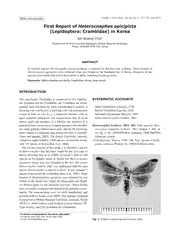
First Report of Heterocnephes apicipicta (Lepidoptera: Crambidae) in Korea PDF
Preview First Report of Heterocnephes apicipicta (Lepidoptera: Crambidae) in Korea
Short communication Korean J. Syst. Zool. Vol. 26, No. 2: 171-172, July 2010 First Report of Heterocnephes apicipicta (Lepidoptera: Crambidae) in Korea Sei-Woong Choi* Department of Environmental Education, Mokpo National University, Muan, Jeonnam 534-729, Korea ABSTRACT A crambid species, Heterocnephes apicipictaInoue, is reported for the first time in Korea. Three females of Heterocnephes apicipicta were collected from two islands in the Southern Sea of Korea. Diagnosis of the species is provided with a brief description of adult, including female genitalia. Keywords:Heterocnephes apicipicta, Crambidae, Korea, new record INTRODUCTION The superfamily Pyraloidea is comprised of two families, SYSTEMATIC ACCOUNTS the Pyralidae and the Crambidae: the Crambidae are distin- guished from Pyralidae by many morphological features: a Order Lepidoptera Linnaeus, 1758 forewing vein with R free, a forewing with oval sclerotization Family Crambidae Latreille, 1810 5 costad of base of vein A , a tympanal chamber with an Subfamily Pyraustinae Meyrick, 1890 1++2 open cephalad, tympanum and conjunctivum that lie at an Genus HeterocnephesLederer, 1863 obtuse angle, the presence of a lobulus, the presence of a praecinctorium, an accessory tympana present in the metatho- Heterocnephes Lederer, 1863: 402. Type species: Hete- rax, male genitalia without uncus arms, and an A8 larval seg- rocnephes scapulalis Lederer, 1863, ibidem 7: 402, pl. ment without a sclerotized ring around the base of seta SD1 14, fig. 5. TL: [INDONESIA] Amboina, [SOLOMONS] (Nuss and Speidel, 2005). The family Crambidae currently Solomons islands. comprises approximately 1900 species around the world, ==CharitoprepesWarren, 1896: 136. Type species: Charito- with 135 species in Korea(Bae et al., 2008). prepes lubricosaWarren, TL: [INDIA] Khasia Hills. The primary purpose of this study is to describe a species of Heterocnephes that has been found for the first time in Korea. Recently Bae et al.(2008) reviewed a total of 349 species of Pyraloidea found in Korea, but Heterocnephes apicipicta Inoue was not included in the list. The genus Heterocnephes Lederer 1863 was established with the type species HeterocnephesscapulalisLederer. It now includes 7 species from around the world(Beccaloni et al., 2003). Three females of Heterocnephes apicipictawere collected on two islands in the South Sea, Gageo-do(Sinan-gun) and Bogil- do(Wando-gun), in the Jeonnam province. These moths were externally examined and dissected for genitalia exami- nation. The nomenclature used for adult morphology and genitalia follows Goater et al.(2005). The material examined is preserved at Mokpo National University, Jeonnam, Korea (M.N.U.). Abbreviations used in the text are as follows: TL. Type locality; and [JN] Jeollanam-do(==Jeonnam). 0 1 2 *To whom correspondence should be addressed Tel: 82-61-450-2783, Fax: 82-61-450-2789 E-mail: [email protected] Fig. 1.A Heterocnephes apicipictaInoue adult. Sei-Woong Choi large dark brown. Hindwing ground color brown; discoidal dot dark brown. Female genitalia(Fig. 2). Papillae anales rounded, consisting of a thin layer and surface with minutely dentate, dorsally containing a pair of large tongue-shaped processes. Apophyses anteriores are the same length as apo- physes posteriores. Antrum simple, membranous. Ductus bursae long, membranous, with a colliculum. Corpus bursae large, ovate with a pair of long patch-like signa. Biology. In Japan this species is bivoltine from May to June and from August to September(Inoue, 1982). We surveyed the islands of Bogil-do and Gageo-do from May to October, but the spring generation was not found. Distribution. Japan, China, Korea. ACKNOWLEDGEMENTS I would like to thank Miss Marana Park, Mr. Jeong-Seop An, Mr. Sang-Duck Na and Mr. Chul-Gee Lee for sampling moths. This study was carried out by the bioinventory pro- ject of Is. Gageo-do from National Institute of Environmen- tal Research, Korea. REFERENCES Bae, Y.S., B.K. Byun and M.K. Paek, 2008. Pyralid moths of Korea(Lepidoptera: Pyraloidea). Korea National Arboretum, Fig. 2.Female genitalia of Heterocnephes apicipictaInoue. Samsungad.com, Seoul, 426pp. Beccaloni, G.W., M.J. Scoble, G.S. Robinson and B. Pitkin 1*Heterocnephes apicipictaInoue(Figs. 1-2) (Eds), 2003. The Global Lepidoptera Names Index(LepIn- dex). World Wide Web electronic publication. http://www. Heterocnephes apicipicta Inoue, 1963: 109, figs 2, 8. TL: nhm.ac.uk/entomology/lepindex [accessed 30 May 2010]. [JAPAN]. Goater, B., M. Nuss and W. Speidel, 2005. Microlepidoptera of Europe, Volume 4, Pyraloidea I. Apollo Books, Stenstrup, Material examined. [JN] 2♀ Is. Bogil-do, JN: Wando, N 304 pp. 34�08′46′′ E 126�32′40′′, 85m, 22 Aug. 2008(M.N.U.); 1♀ Inoue, H., 1963. Descriptions and records of some Pyralidae Is. Gageo-do, JN: Sinan, N 34�04′20′′ E 125�06′50′′, 446m, from Japan(VI)(Lepidoptera). Kontyu, 31: 107-112. 16 Aug. 2009(M.N.U.). Inoue, H., 1982. Pyralidae. Moths of Japan. Vol 1. p. 332, Ko- Diagnosis. This species is distinguished by a large dark brown dansha, Tokyo. apical dot and a dark brown discoidal dot on the forewing, Lederer, J., 1863. Beitrag zur Kenntniss der Pyralidinen. Wien. and a dark brownish discoidal dot on hindwing. The body and Ent. Monatschr., 7: 331-504. legs are covered with white hairs. The female genitalia are Nuss, M and W. Speidel, 2005. Introduction. In: Microle- pidoptera of Europe, Volume 4, Pyraloidea I(Eds., B. distinguished by large round papillae anales, a simple antrum, Goater, M. Nuss and W. Speidel). pp. 7-20. Apollo Books, long ductus bursae with a colliculum, and large ovate corpus Stenstrup. bursae with a pair of patch-like signa. Warren, W., 1896. New genera and species of Pyralidae, Thyridi- Description(Fig. 1). Wingspan 21-24mm. Female antennae dae, and Epiplemidae. Ann. Mag. nat. Hist., 17: 131-150, filiform; frons covered with brownish hairs; labial palpi up- 202-216. turned, densely covered with long brownish hairs. Body and legs whitish. Forewing slender, apically projected; ground Received June 14, 2010 color dark brown; discoidal dot large dark brown; apical dot Accepted July 8, 2010 1*남방끝점들명나방(신칭) 172 Korean J. Syst. Zool. 26(2), 171-172
